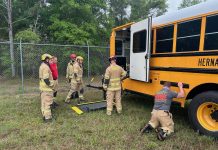Our analysts are deeply concerned with a trend we are seeing across the nation. School employees and students are being taught to attack an “active shooter” as a last resort. While every approach we have seen emphasizes the concept should only be used when there is no other viable option, controlled simulations and at least one actual incident have revealed that people sometimes do not retain this information as intended.
For example, while keynoting a state homeland security conference last month, I asked a volunteer to come to stage to help me. I instructed the person to respond to a video crisis simulation by telling me and the audience what they would do as a school employee faced with the situation. The video depicts a group of students on a school bus. One student jumps to his feet, draws a large semi-automatic pistol and places the gun to his temple with his finger on the trigger while threatening to kill himself (note that we use replica firearms for all of our training videos).
After the person assisting me told me what she would do in the first 30 seconds, I asked the audience if anyone had any different actions steps that they would take. A man’s hand shot straight up when I asked the question. He stated that she should have disarmed the student. Not one of the 400 or so public safety officials in attendance agreed. The man was insistent that school employees can be trained to reliably disarm someone with a 16-hour class.
I completed 80 hours of training in these types of techniques when I attended the basic police academy, and I could not reliably disarm the student as the situation is depicted in the scenario. I learned that the attendee was an instructor for the program he described. Other instructors for the same program in attendance later told me that his response was not consistent with what instructors are taught. This begs the question, when an instructor can make such a deadly mistake, is it even more likely that school employees and students might misapply the information?
This instructor was not the first person to react in this manner after participating in a training program or after viewing the Houston Police Department’s video “Run, Hide, Fight.” Though now endorsed by the U.S. Department of Homeland Security and the U.S. Department of Education, experts are heavily divided on the practicality of this approach. After seeing a number of test subjects who have viewed this video respond by telling us they would attack people inappropriately, every one of our more than 30 analysts feels that some trainees will respond inappropriately to situations that do not involve an active shooter just as this instructor did. We are so concerned about this that we decided to add a chapter on active shooter response training to our new book, “Staying Alive – How to Act Fast and Survive Deadly Encounters,” due out by Barron’s this spring.
This is an important issue for every school transportation director in America because millions of people have now viewed the “Run, Hide, Fight” video online. This means that students who have viewed this video may react just as school employees have been doing during our assessments. We have run simulations in more than 20 states since the video was released and have seen these types of reactions from New England to New Mexico.
Pupil transportation personnel should consider the very real possibility that students who have viewed this video or participated in training on attacking an active shooter may try to disarm a hostage taker, student threatening to kill themselves, or someone brandishing a gun without firing it. As three students have committed suicide with a gun on school property in the last nine months alone in the U.S. and one bus driver has been taken hostage, this is a very real concern.
As well-intentioned as these approaches may be, there are significant indications that there are likely to be serious injuries and deaths as people misapply the concepts taught. Though the instructions provided seem crystal clear, the reactions of people under controlled simulations and actual incidents have sometimes been quite different than those intended. While some approaches seem fine from the theoretical perspective, application under the extreme stress of an event can produce a far different and sometimes deadly result.
Mike Dorn is the executive director of Safe Havens International, a global, non-profit school safety center for kindergarten through 12th grade. He is a former school district police chief for Bibb County, Ga., a former school safety specialist for the Georgia Emergency Management Agency and a former anti-terrorism planner and lead program manager at the Georgia Office of Homeland Security.















